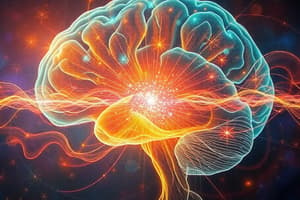Podcast
Questions and Answers
According to the James-Lange theory of emotion, what comes first?
According to the James-Lange theory of emotion, what comes first?
- The cognitive appraisal of the situation.
- The conscious feeling of an emotion.
- The physiological arousal. (correct)
- The behavioral expression of the emotion.
Which physiological changes are typically associated with the activation of the sympathetic nervous system during an emotional response?
Which physiological changes are typically associated with the activation of the sympathetic nervous system during an emotional response?
- Increased sweat gland activity and decreased heart rate.
- Increased respiration rate and decreased digestion. (correct)
- Decreased respiration rate and increased digestion.
- Decreased sweat gland activity and increased heart rate.
Which of the following best describes the role of the parasympathetic nervous system in emotional regulation?
Which of the following best describes the role of the parasympathetic nervous system in emotional regulation?
- Conserving energy and promoting 'rest and digest' functions. (correct)
- Increasing heart rate and blood pressure during stressful situations.
- Preparing the body for 'fight or flight' responses.
- Activating the body during events that require emotional demands.
How does muscular activation relate to the expression of emotion?
How does muscular activation relate to the expression of emotion?
What is the main difference between the James-Lange theory and Cognitive theory of emotion?
What is the main difference between the James-Lange theory and Cognitive theory of emotion?
Which of the following is NOT a typical physiological response mediated by the sympathetic nervous system during an emotional event?
Which of the following is NOT a typical physiological response mediated by the sympathetic nervous system during an emotional event?
How do the sympathetic and parasympathetic nervous systems work together to regulate emotional responses?
How do the sympathetic and parasympathetic nervous systems work together to regulate emotional responses?
Muscular activation during emotional responses can lead to which of the following?
Muscular activation during emotional responses can lead to which of the following?
Which of the following scenarios best illustrates the concept of 'incentive theory' in motivation?
Which of the following scenarios best illustrates the concept of 'incentive theory' in motivation?
Damage to the prefrontal cortex is most likely to result in which of the following?
Damage to the prefrontal cortex is most likely to result in which of the following?
Which of the following is the LEAST likely example of an instinctual behavior in humans?
Which of the following is the LEAST likely example of an instinctual behavior in humans?
According to the cognitive theory of emotion, what role does physiological arousal play in the emotional experience?
According to the cognitive theory of emotion, what role does physiological arousal play in the emotional experience?
Which of the following best explains the concept of homeostasis in the context of drive theory?
Which of the following best explains the concept of homeostasis in the context of drive theory?
Which of the following is a key difference between drive theory and incentive theory?
Which of the following is a key difference between drive theory and incentive theory?
The 'shaky suspension bridge' experiment primarily illustrates which concept related to emotion?
The 'shaky suspension bridge' experiment primarily illustrates which concept related to emotion?
An individual who enjoys activities with a high degree of risk and excitement, such as skydiving or extreme sports, is likely exhibiting behaviors associated with which motivational theory?
An individual who enjoys activities with a high degree of risk and excitement, such as skydiving or extreme sports, is likely exhibiting behaviors associated with which motivational theory?
What is the main argument of the integrative embodiment theory of emotions?
What is the main argument of the integrative embodiment theory of emotions?
A researcher is studying the role of the limbic system in emotional regulation. Which two structures should the researcher focus on?
A researcher is studying the role of the limbic system in emotional regulation. Which two structures should the researcher focus on?
In the Strack, Martin & Stepper (1988) experiment, what was the key finding regarding facial expressions and emotional experience?
In the Strack, Martin & Stepper (1988) experiment, what was the key finding regarding facial expressions and emotional experience?
If a person is unable to restrain violent urges, which area of the brain might be deficient?
If a person is unable to restrain violent urges, which area of the brain might be deficient?
According to the cognitive theory of emotion, how does the cognitive assessment of a situation influence the emotional experience?
According to the cognitive theory of emotion, how does the cognitive assessment of a situation influence the emotional experience?
Misattribution of arousal occurs when:
Misattribution of arousal occurs when:
What is a central tenet of the James-Lange theory of emotion that contrasts with the cognitive theory?
What is a central tenet of the James-Lange theory of emotion that contrasts with the cognitive theory?
Which of the following scenarios best illustrates the integrative embodiment theory of emotions?
Which of the following scenarios best illustrates the integrative embodiment theory of emotions?
Flashcards
Emotion
Emotion
An increase or decrease in physiological activity accompanied by feelings and behaviors/expressions.
Sympathetic Nervous System (SNS)
Sympathetic Nervous System (SNS)
System that activates the body during arousal, like stress or threat.
Fight or Flight Response
Fight or Flight Response
Prepares the body for intense physical activity; fight or flight response.
Parasympathetic Nervous System
Parasympathetic Nervous System
Signup and view all the flashcards
Muscular Activation
Muscular Activation
Signup and view all the flashcards
James-Lange Theory
James-Lange Theory
Signup and view all the flashcards
Cognitive theory
Cognitive theory
Signup and view all the flashcards
Integrative Embodiment Theory of Emotions
Integrative Embodiment Theory of Emotions
Signup and view all the flashcards
Cognitive Theory of Emotion
Cognitive Theory of Emotion
Signup and view all the flashcards
Misattribution of Arousal
Misattribution of Arousal
Signup and view all the flashcards
Integrative Embodiment Theory
Integrative Embodiment Theory
Signup and view all the flashcards
Emotions: Integrative Theory
Emotions: Integrative Theory
Signup and view all the flashcards
Facial Feedback Hypothesis
Facial Feedback Hypothesis
Signup and view all the flashcards
The Emotional Brain
The Emotional Brain
Signup and view all the flashcards
Amygdala
Amygdala
Signup and view all the flashcards
Limbic System
Limbic System
Signup and view all the flashcards
Hippocampus
Hippocampus
Signup and view all the flashcards
Prefrontal Cortex & Emotion
Prefrontal Cortex & Emotion
Signup and view all the flashcards
Motivation Definition
Motivation Definition
Signup and view all the flashcards
Instinct
Instinct
Signup and view all the flashcards
Drive Theory
Drive Theory
Signup and view all the flashcards
Incentive Theory
Incentive Theory
Signup and view all the flashcards
Study Notes
- Chapter 9 focuses on the limbic system, emotion and motivation
- Learning objectives include explaining theoretical perspectives on emotions, identifying responsible brain structures and the nervous system, and explaining theoretical perspectives on motivation.
Emotions
- Emotion involves asking what an emotion is, what defines feelings, how feelings are measured, and the physiological reaction of emotion
- Emotion is an increase or decrease in physiological activity accompanied by feelings characteristic of the emotion
- Often accompanied by a set of behaviors or facial expressions
- The sympathetic nervous system is involved in regulating emotions, activating the body during arousal and events requiring emotional responses
- The sympathetic nervous system increases respiration rate, sweat gland activity, and blood pressure/heart rate, diverting blood to muscles for fight or flight
- The sympathetic nervous system decreases digestion
- The autonomic nervous system is involved in motor-related functions
- The sympathetic nervous system relates to strong emotional demand, and helps the body cope with high-demand events
Muscular Activation and Emotion
- Muscular activation is involved in the external expression of emotion
- Bodily tension can arise from muscular activation
- Physiological arousal and emotions can be explained with the James-Lange theory (1893), cognitive theory (1962), and integrative embodiment theory of emotions (2013)
James-Lange Theory
- Emotional experience results from physiological arousal that precedes it
- Different emotions are the result of different patterns of arousal
- Physiological arousal leads to an emotional experience
- Sweating and palpitations can culminate in an emotional experience of fear
Cognitive Theory
- The identity of emotion is based on cognitive assessment of the situation, and the intensity of the physiological arousal contributes only to the intensity of the emotion
- Cognition can mix up environmental cues to explain emotion
- Swaying footbridges and sexual attraction is cited with the theory of misattribution of arousal
Integrative Embodiment Theory of Emotions
- Barlassina and Newen (2013) argue neither physiological response nor congnitive assessment adequately explain emotions
- Bodily sensations are a critical component of emotion, but these perceptions must be integrated with cognitive information
- Facial expressions contribute to emotional experience
- Induced facial poses may influence how a person interprets their environment
- Holding a pen between the teeth produces a smile, and between the lips produces a frown
Emotional Brain Structures
- The limbic system is the brain structure mainly responsible for emotion, it has a network of structures arranged around the upper brain stem
- It is located at the forebrain
- The hippocampus is responsible for memory, and the amygdala for emotion
- Later research has found the emotion involves structures at all levels of the brain contrary to the amygdala-centric view
- Deficiencies in this area may cause people to be unable to make rational judgments or restrain violent urges
- Abnormalities to this area are seen in most people with depression and schizophrenia
Motivation
- Motivation refers to the set of factors that initiate, sustain, and direct behaviors
- Approaches to motivation are defined by instinct, drive, incentive, and arousal theory
Instinct
- Instinct is a complex behavior that is automatic, unlearned, unmodifiable, and occurs in all members of a species (Birney and Teevan, 1961)
- Examples are migration and parental behavior in animals
- Examples in humans are caring for young through a parental instinct, as well as survival instincts under attack
Drive Theory
- Needs derive from physical conditions
- Drinking when thirsty and eating when hungry represent examples
- Any bodily systems must be kept in balance or equilibrium, which involves homeostasis
- If bodily balance is disrupted, an aroused condition or drive impels the individual to engage in eating, drinking, and seeking warmth
Incentive Theory
- People are motivated by external stimuli, not just internal needs (Bolles, 1975)
- External stimuli involve incentives such as clothing, mates, valuable things, money, and good grades
Arousal Theory
- People behave in ways that keep them at their preferred level of stimulation (Fiske and Maddi, 1961)
- Different people maintain different optimum arousal levels for activating sensation seeking behaviours
- Adrenaline junkies and eating fugu is cited
Studying That Suits You
Use AI to generate personalized quizzes and flashcards to suit your learning preferences.
Related Documents
Description
Chapter 9 explores the limbic system, emotion, and motivation. It examines theoretical perspectives on emotions, identifies responsible brain structures and the nervous system. It also explains theoretical perspectives on motivation.




